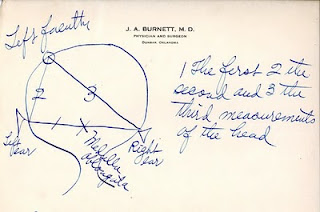Sketches from Burnett Letter
 In a file folder titled “fingerprints” largely containing correspondence from 1928, I found a number of documents that support the idea that Hardman actually practiced phrenology during his time as Governor (1927-1932).
In a file folder titled “fingerprints” largely containing correspondence from 1928, I found a number of documents that support the idea that Hardman actually practiced phrenology during his time as Governor (1927-1932).Among several documents referencing phrenology in the folder is a pamphlet titled “Three Methods of Measuring Phrenological Faculties,” written by Dr. J.A. Burnett, M.D. of Dunbar, Oklahoma. This same Dr. Burnett sent Governor Hardman a letter providing sketches of his preferred step-by-step methods for head measuring. The folder also contains dozens of letters exchanged between Governor Lamartine Hardman and government officials and mental health providers in various surrounding states, discussing the potential use of fingerprints in determining criminality and insanity in prisoners.
Sealing Hardman’s connection to phrenology are several news clippings referencing the conviction and execution of three individuals implicated in a murder in Georgia in September 1928. The article, “Georgia Executive uses Pictures as Aid in Deciding Pleas Made for Mercy,” outlines Hardman’s use of phrenological principles in deciding clemency cases. The article quotes Hardman as follows:

“Believing that the verdict is just and that the parties are guilty, and with the additional impression of the pictures of Mr. and Mrs. Clifford Thompson and reading as best I can their physiognomy and phrenology, I feel that the court rendered a righteous verdict.”
It goes on to describe that the Governor believed “careful physical examinations, paying especial attention to faces, heads, and finger prints, show whether prisoners are criminal types and whether they are insane.”
So there you have it folks. This series of documents indicates that Lamartine Hardman took more than just a curious interest in phrenology, as late as 1928. This revised conclusion demonstrates how more extensive research can lead to more refined answers in pursuit of historical questions. Further, I think this is a great example of how much can be learned when we utilize the three dimensional objects in our collections as well as the paper documents. Had we not decided to display the phrenology skull for this month's feature, I might never have ventured into this correspondence file in the Hardman collection.
Close-up of sketch on Page 3

For more information on the Lamartine G. Hardman Papers, please visit our website at http://www.libs.uga.edu/russell or email russlib@uga.edu.
Post by Jan Levinson, Assistant Outreach Archivist, Russell Library.




No comments:
Post a Comment